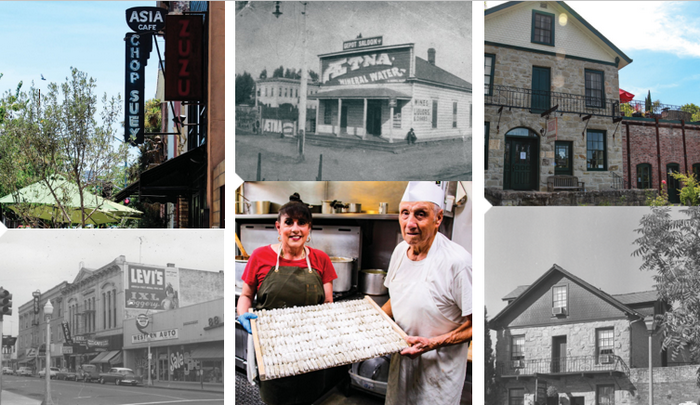What was the first restaurant in Napa County? That depends on the definition of “restaurant.” When Harrison Pierce erected the Empire Saloon on Main Street near Third in 1848, he became the first to sell meals in a building, as opposed to the canvas tents of new arrivals and transient visitors. His basic menu of $1 beef, hard bread, and coffee satisfied Napa’s earliest residents, but would hardly impress contemporary culinary connoisseurs.
In the mid-19th century, saloons, restaurants, and hotels were not that dissimilar. All three offered lodging and food, though the quality and quantity of both differed dramatically depending on the proprietor. Gradually these enterprises began specializing. Saloons like the Eagle in Yountville and the Railroad House in St. Helena offered snacks and small meals like oysters, tamales, and merchants’ lunches alongside alcoholic drinks and cigars. Posh hotels like the Napa Hotel in downtown Napa and the Magnolia Hotel in Calistoga had comfy rooms and an in-house kitchen, a separately managed restaurant on site, or both. Summer vacation spots like Aetna Springs Resort and Napa Soda Springs wowed their guests with extravagant dinners.
Restaurants eventually shifted focus solely on gustatory delights. The vast menus of local restaurants contained a mind-boggling array of fowl, fish, and flesh and other “delicacies of the season,” and were topped off with sumptuous pies and puddings.
Californians were accustomed to Mexican dishes in the 1800s, but tamales burst onto the mainstage toward the end of the century. Home cooks, many of whom were Latina, sold tamales in grocery stores, saloons, restaurants, and from street carts. Some, like Juana Garcia, Inez Carravajal, and Annie Olds, converted the ground floor of their homes into dining parlors where customers gorged on chili con carne, tamales, and enchiladas fresh from their kitchens.
As new groups of people immigrated into the United States seeking a better life for their families, they brought with them foods and cooking techniques from home. Pizza, ravioli, spaghetti, and lasagne became staples in American households, but out of all the dishes introduced by Italian cooks, it was malfatti that drove Napans wild. Although many believe Theresa Tamburelli, the second owner of the much-beloved Depot Hotel in downtown Napa, invented malfatti, it is actually a traditional Italian dish. No matter. To this day, it remains a local favorite. One of the Depots’ former cooks, Clemente Cittoni, was trained to make Theresa’s malfatti recipe and he, along with three generations of Cittonis, continue to create and sell the popular dumplings at Clemente’s Take Out counter located in the back of Val’s Liquor Store on Third Street.

Chinese immigrants introduced Americans to a culinary style very different from what they were used to. The Chan family has been in Napa County since 1860 and were prominent residents of Chinatown. Shuck Chan watched with rapt attention as his mother, Kin Lim, whipped up traditional dishes from the Pearl River Delta region. He was quite the cook himself and worked in and opened several Chinese restaurants during his life. In 1938, Low Yuen and his brothers took over Napa’s A-1 Café, which was located in the Napa Opera House building and turned it into a must-visit restaurant. Locals couldn’t get enough of their classic yet mouth-watering chow mein, fried rice, and egg foo young. Low Yuen’s brother, Bing Hun Yuen worked at A-1 for 12 years before opening the Asia Café on Main St, between Second and Third, where it still operates today.
The population boom of the postwar era and the rise of tourism in the 1970s triggered a seismic shift in how Napans thought about food. Saloons, tamale parlors, and oyster cellars gave way to burger joints, lunch counters, and family-friendly restaurants. Jonesy’s lured in pilots with its exquisite steaks, Taylor’s Refresher (now Gotts Roadside) filled the bellies of hungry teens, and Palby’s played host to community groups and family get-togethers.
Domaine Chandon hit on the inspired idea to open a haute cuisine kitchen, and wineries all over the valley began hiring personal chefs and hosting food pairings to appeal to a new generation of wine aficionados. A wave of fine dining options flooded the up-valley region, but Napa city struggled to attract diners with big wallets. Eateries came and went, but the ones that won the hearts and stomachs of eager consumers were those that merged local traditions, national trends, and enticing flavors. Case in point: the French Laundry.
Don and Sally Schmitt opened the restaurant in 1978. The dilapidated structure was built around 1896 by Scottish stone- mason Alexander “Gus” Clark from locally quarried stone. Originally the building housed the Eagle Hotel and saloon, managed by Spanish proprietor Pierre Guillaume. A few years later, his brother- in-law French immigrant John Lande moved in and converted it to a home and a French laundry. Guillaume opened the Magnolia Hotel (today the Maison Fleurie B&B) a few blocks away. The laundry gave way to a boarding house and, if rumors are true, a brothel, before being left vacant.
The Schmitts’ country French menu charmed guests with its elegant yet rustic taste. Then in 1994, the Schmitts sold to Thomas Keller, and everything changed. Keller went upscale–way upscale. Celebrities and socialites descended on the little town to sample his world-class French fare. The taste buds of tourists continue to drive the local economy, but today there is a better balance between cheap, mid- range, and high-priced dining. In 2006, after years of winning award after award, the French Laundry earned three Michelin stars, confirming its place in Napa’s food history.
What does the future hold for Napa County restaurants? Will the haute cuisine continue its dominance or give way to something new? Who knows. But if the past is any indication, whatever comes next will be nothing short of delicious.
 ABOUT THE AUTHOR:
ABOUT THE AUTHOR:
Alexandria Brown was raised in Napa and has spent most of her life living there. She is a librarian, local historian, writer, and author. She writes about speculative fiction and young adult literature for Tor.com, as well as on her blog. Diversity, equity, and inclusion set the founda- tion of all her work. Her latest book, “Lost Restaurants of Napa Valley and Their Recipes” is available locally at Bookmine and Copperfields, or wherever books are sold.

